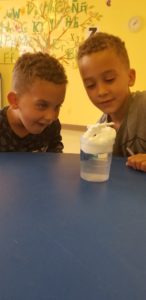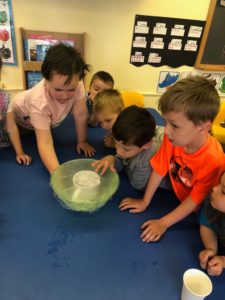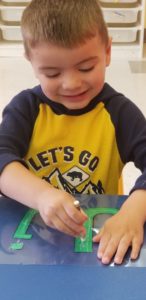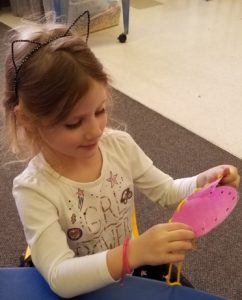This week we started working with a new topic: “Water Cycle, Plants, and Light”.
 In order to understand the water and why it rains, kids need to know about the water cycle first. So, this week we learned all about how the water cycle works. Water covers more than 70% of the earth’s surface, and living things need water to survive. The water cycle is nature’s way of purifying, circulating, and replenishing water. Kids learned the four basic steps in the water cycle:
In order to understand the water and why it rains, kids need to know about the water cycle first. So, this week we learned all about how the water cycle works. Water covers more than 70% of the earth’s surface, and living things need water to survive. The water cycle is nature’s way of purifying, circulating, and replenishing water. Kids learned the four basic steps in the water cycle:
1. Evaporation: When heat from the sun turns liquid water into gaseous water vapor, causing it to rise into the air.
2. Condensation: When gaseous water vapor cools at high elevations and becomes liquid (or solid) again
3. Precipitation: When liquid water (e.g., rain) or solid water (e.g., snow) falls to the ground.
4. Collection: When large amounts of water gather in oceans, lakes, rivers, and streams
 We did a simple demonstration to help the kiddos understand the basic elements of the water cycle. The demonstration also shows why our rain water is drinkable despite, the fact that much of our rain water comes from the salty ocean. We used salt, water, and ice. In a larger container I put hot water and salt then I stirred well to make the ocean(evaporation). I placed and small container in the middle of the larger container to collect the rain that falls. I covered the top of the container with a plastic wrap, this provided water to condense into clouds. I then placed some ice cubes into the center of the cling wrap covering the top of the container, so the cool ice in the “sky” caused the evaporated water to condense when it rose up. After several minutes kids could see water condensing into “clouds”, then, precipitation began, water dropped from the plastic cling wrap back into the ocean. Some of that water fell down in the small container.
We did a simple demonstration to help the kiddos understand the basic elements of the water cycle. The demonstration also shows why our rain water is drinkable despite, the fact that much of our rain water comes from the salty ocean. We used salt, water, and ice. In a larger container I put hot water and salt then I stirred well to make the ocean(evaporation). I placed and small container in the middle of the larger container to collect the rain that falls. I covered the top of the container with a plastic wrap, this provided water to condense into clouds. I then placed some ice cubes into the center of the cling wrap covering the top of the container, so the cool ice in the “sky” caused the evaporated water to condense when it rose up. After several minutes kids could see water condensing into “clouds”, then, precipitation began, water dropped from the plastic cling wrap back into the ocean. Some of that water fell down in the small container.
Kids could taste the water of the small container and they noticed that the water wasn’t salty compared to the ocean water we began with. That is because only the ocean water evaporates, not the salt that is in it. Thus, rain water is okay to drink even if it originally came from the salty ocean. After all, we did a precipitation experiment too with coloring food, shaving cream, and water.
 Letra
Letra
This week we learned all about the letter “J”/letra J. Be sure to point out the letter that we practice when you are reading. The English letter (J) can be pronounced as (llei). While the Spanish pronunciation is; J (hotah) makes an “h” sound as in English him. Some examples:
Juego/game,
Jugo/juice,
Joya/jewel,
Jeep/jeep,
Jirafa/giraffe,
Jaula/cage.
 Números
Números
This week we started working with number 16. We had a fun time playing with this number and using some items for sorting and counting. We used the water cycle topic to do different activities:counting clouds and counting water drops. It was a simple activity to help kids practice counting and with their number recognition. As well they counted and tracing the number with play dough.
This week worked with the diamond /diamante shape. The kids played with the shape, tracing it with their fingers and lacing shapes. Also, the kids continued reinforcing the colors names that they’ve learned: rojo/red, azul/blue, verde/green, and amarillo/yellow, purpura/purple, cafe/brown, anaranjado o naranja/orange, black/negro, and we introduced the new color to learn white/blanco. This week kids colored a sheet of paper using the colors that they were and are learning, saying the colors as they used them.
Have a good weekend!

